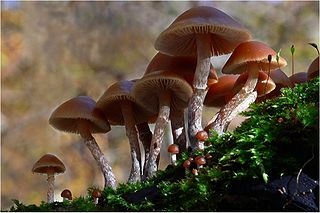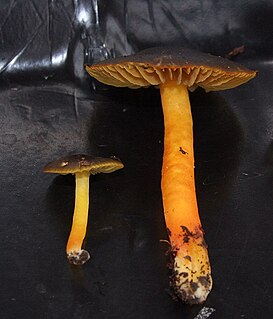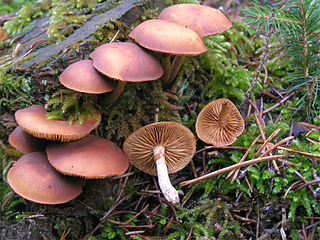
The Flora of Australia is a 59 volume series describing the vascular plants, bryophytes and lichens present in Australia and its external territories. The series is published by the Australian Biological Resources Study who estimate that the series when complete will describe over 20 000 plant species.

The Fungi of Australia form an enormous and phenomenally diverse group, occupying a huge range of freshwater, marine and terrestrial habitats with many ecological roles, for example as saprobes, parasites and mutualistic symbionts of algae, animals and plants, and as agents of biodeterioration. Where plants produce, and animals consume, the fungi recycle, and as such they ensure the sustainability of ecosystems.
Anthony "Tony" M. Young is an Australian mycologist based in Queensland, affiliated with the University of Queensland. He has published several books on fungi as well as a monograph on Australian Hygrophoraceae, resulting from his research on Hygrocybe and related genera. In 2007, he was a co-author of a review of the genus Ramaria in Australia, a work in progress which will see the likely description of 15 new Australian species and increase the total number to 50.

Galerina marginata is a species of poisonous fungus in the family Hymenogastraceae of the order Agaricales. Prior to 2001, the species G. autumnalis, G. oregonensis, G. unicolor, and G. venenata were thought to be separate due to differences in habitat and the viscidity of their caps, but phylogenetic analysis showed that they are all the same species.
Thomas William May is a mycologist and the curator of the fungal collection at the National Herbarium of Victoria where he specialises in the taxonomy and ecology of Australian macrofungi. He is most notable for the comprehensive bibliographical lists of all Australian fungi published thus far; Volume 2A, published in 1997, and Volume 2B, published in 2003. as well as the originator of Fungimap, an Australia-wide mapping fungal mapping scheme based on observations of 100 easily identified macrofungi. May was awarded the 2014 Australian Natural History Medallion.

Omphalotus nidiformis, or ghost fungus, is a gilled basidiomycete mushroom most notable for its bioluminescent properties. It is known to occur primarily in southern Australia and Tasmania, but was reported from India in 2012 and 2018. The fan- or funnel-shaped fruit bodies are up to 30 cm (12 in) across, with cream-coloured caps overlain with shades of orange, brown, purple, or bluish-black. The white or cream gills run down the length of the stipe, which is up to 8 cm (3 in) long and tapers in thickness to the base. The fungus is both saprotrophic and parasitic, and its fruit bodies are generally found growing in overlapping clusters on a wide variety of dead or dying trees.

Porpolomopsis lewelliniae, commonly known as the mauve splitting wax-cap, is a gilled fungus of the waxcap family found in wet forests of eastern Australia and New Zealand. The small mauve- or lilac-coloured mushrooms are fairly common and appear in moss or leaf litter on the forest floor in autumn, and are biotrophic. The key distinguishing feature is the splitting of the cap dividing down the middle of the individual gills.

Károly Kalchbrenner was a Hungarian mycologist. He trained in theology early in life and became a priest in Spišské Vlachy, north-eastern Slovakia. His contributions include the publication of 60 papers and description of more than 400 fungi from Europe, Asia, Australia and South America. He wrote and illustrated the Icones Selectae Hymenomycetum Hungariae. Among those he later collaborated with are Ferdinand von Mueller in Victoria, Australia, John Medley Wood in South Africa, Mordecai Cubitt Cooke in England and Felix von Thümen in Austria. He was elected a full member of the Hungarian Academy of Sciences, and a corresponding member of the Linnean Society of New South Wales.

Hygrocybe aurantipes is a gilled fungus of the waxcap family found in a few scattered locations in wet forests in eastern Australia. It is a distinctive small mushroom with a 2–4 cm diameter olive-brown cap and golden-yellow stipe and gills, not easily confused with any other species. Known only from Lane Cove Bushland Park in Sydney's suburban Lower North Shore, Hazelbrook and Mount Wilson in the Blue Mountains, it has been designated as vulnerable as defined by the NSW Threatened Species Conservation Act 1995, by the New South Wales Government.
Tsuguo Hongo was a Japanese mycologist who specialized in the biogeography and taxonomy of Agaricales.
Echinostelium is a genus of slime mould, and the only genus in the family Echinosteliaceae, or Echinosteliidae. It was discovered by Heinrich Anton de Bary in 1855, apparently near Frankfurt am Main. Some species of Echinostelium have a sexual life cycle; others have been shown to be asexual. The plasmodium can divide vegetatively, in a process called plasmotomy, to distinguish it from true cell division.

Galerina sulciceps is a dangerously toxic species of fungus in the family Strophariaceae, of the order Agaricales. It is distributed in tropical Indonesia and India, but has reportedly been found fruiting in European greenhouses on occasion. More toxic than the deathcap, G. sulciceps has been shown to contain the toxins alpha- (α-), beta- (β-) and gamma- (γ-) amanitin; a series of poisonings in Indonesia in the 1930s resulted in 14 deaths from the consumption of this species. It has a typical "little brown mushroom" appearance, with few obvious external characteristics to help distinguish it from many other similar nondescript brown species. The fruit bodies of the fungus are tawny to ochre, deepening to reddish-brown at the base of the stem. The gills are well-separated, and there is no ring present on the stem.
Derek Agutter Reid was an English mycologist.

Amanita australis is a species of fungus in the family Amanitaceae. It is found only in New Zealand, where it occurs in Leptospermum and Nothofagus forest. The species was first described by New Zealand mycologist Greta Stevenson in 1962; in the same publication Stevenson also described what she thought was a unique species, Limacella macrospora, but over 30 years later this was reduced to synonymy with A. australis.

Amanita pekeoides is a species of fungus in the family Amanitaceae. It was first described scientifically by New Zealand mycologist Geoff Ridley in 1991.

Humidicutis mavis is a gilled fungus of the waxcap family. It is found in Australia, Borneo, and New Zealand where the translucent white fungi grows from the ground to a height of 80 mm and a width of 50 mm.

Amanita ochrophylla is a fungus of the family Amanitaceae native to southeastern Australia. Its large and distinctive buff fruit bodies are common after rainfall.

Amanita ananiceps is a species of agaric fungus in the family Amanitaceae native to Australia.
Roy Watling, PhD., DSc, FRSE, F.I.Biol., C.Biol., FLS is a Scottish mycologist who has made significant contributions to the study of fungi both in identification of new species and correct taxonomic placement, as well as in fungal ecology.















